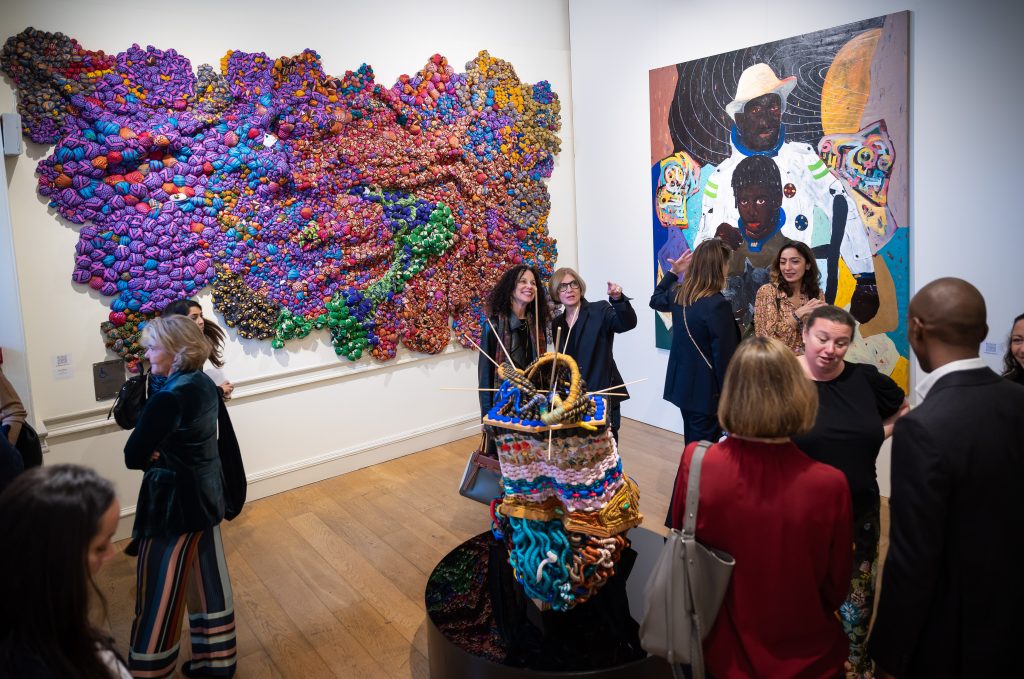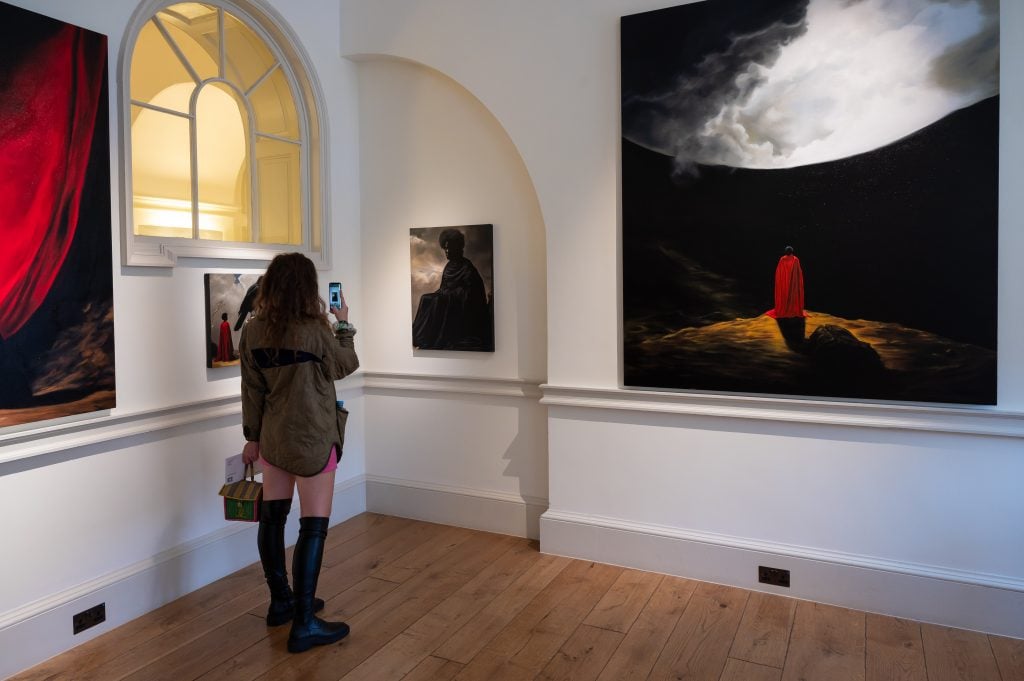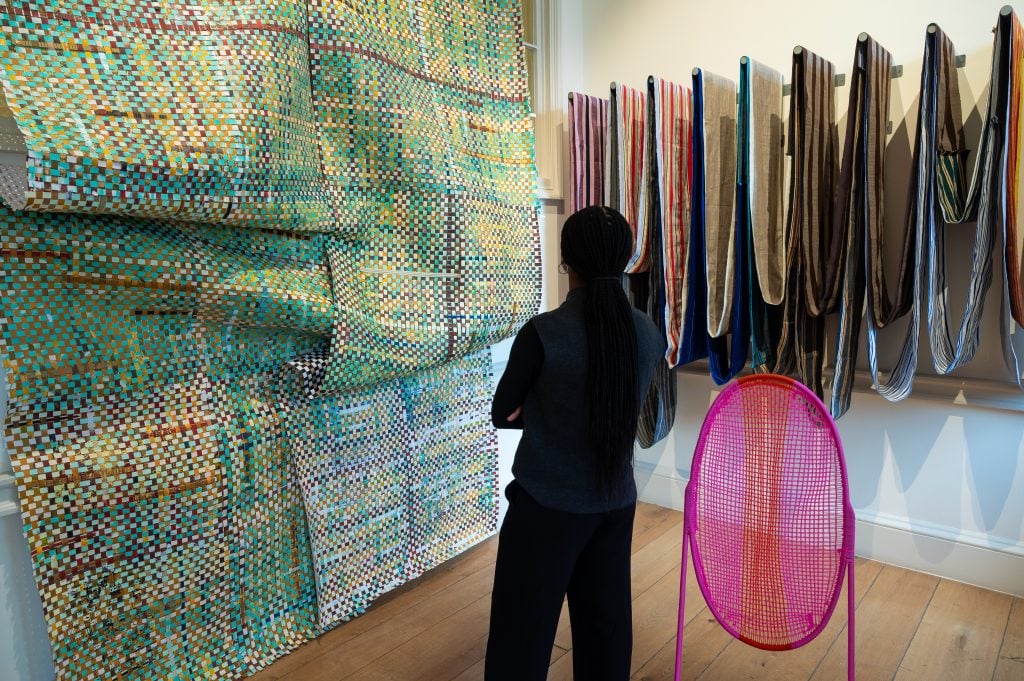Art Fairs
3 Trends We Spotted at London’s 1-54 Art Fair That Could Eclipse the Market’s Penchant for Figuration
The leading international fair dedicated to contemporary African art saw a record number of exhibitors this year.

The leading international fair dedicated to contemporary African art saw a record number of exhibitors this year.

Precious Adesina

This October, 1-54 Contemporary African Art Fair returned to Somerset House for its 11th edition. The event has been a key player in the growing market for work by contemporary African artists since its inception in 2013 and this year was its most ambitious edition yet, featuring 170 artists across 62 galleries. It’s a significant increase from its 47 galleries the year before and a huge leap from the original 15 the event debuted with nine years ago.
Wider appreciation for contemporary African art and art of the African diaspora has grown dramatically over the last decade among galleries and institutions alike. Significantly, major shows at galleries and institutions across London have also highlighted African artists this autumn, including the Joy Labinjo’s “Beloved, Take What You Need” at Tiwani Contemporary and Ghanaian sculptor El Anatsui’s site-specific commission hanging in Tate Modern’s Turbine Hall.
As the market for contemporary African art continues to mature, 1-54 offers critical insight into the growing trends in art-making across the African continent. While figuration has dominated the market up to this point, we took note of three other key themes surfacing at this year’s fair and the artists behind them.

Installation view © Jim Winslet
El Anatsui’s current Turbine Hall commission at Tate Modern is a testament to the fact that the use of everyday items has become an integral part of the practice of numerous contemporary African artists. Composed of thousands of metal bottle caps, Behind the Red Moon is the artist’s largest piece to date and is a commentary on the movement of goods and people under the transatlantic slave trade. The specific liquor bottle tops, sourced in Nigeria, are part of a present-day industry built on colonial trade routes.
At 1-54, the use of found objects could be seen across many artist’s practices, especially those exploring themes of cultural identity. That includes works by Ghanaian artist Caleb Kwarteng Prah, presented by Nil Gallery. Prah uses the doors of trotros–converted minibuses turned into share taxis—to frame his photographs of members of the Ghanaian working class. His piece Dan x Kofi features a whole white door decorated with religious and floral imagery with two individual pictures of a man inside the door’s windows.
Meanwhile, at the Paris-based Afikaris Gallery’s stand, Nigerian ceramicist Ozioma Onuzulike’s Beaded Blouse with Two Front Pockets For August Meeting II is a shirt made of natural palm kernel shells, earthenware and stoneware clays, ash glazes, recycled glasses, and copper wire. The artist has recently used palm kernels in his “Palm Kernel Shell Beads” series as a means of recognizing both the cultural and economic value the seed held in West Africa during and after the slave trade.
Ghanaian artist Kwaku Yaro, whose paintings were featured at the Paris-based Septieme Gallery’s 1-54 booth and were priced around $12,000, uses upcycled carrier bags with a distinctive “Ghana Must Go” design, as well as chequered nylon totes strongly associated with migration in West Africa, to create portraits of Ghana’s youths. Also, the Cape Town gallery Whatiftheworld showed works by South African artist Chris Soal, who creates unusual sculptural pieces using mass-produced objects such as beer bottle tops and bamboo toothpicks, as seen in his work Only Thing You Know.

Installation view © Jim Winslet
Figurative realism in African art may have been the hottest trend both in primary and secondary market sales in recent years, but several artists are experimenting with the human form in new ways. A notable name among the artists at 1-54 was Senegalese mixed-media painter and sculptor Soly Cissé, whose neo-expressionist style paintings have been garnering interest around the globe. His mixed-media piece Le danseur, shown by La Galerie 38, portrayed loosely drawn figures with both human and animal features.
Sudanese artist Salah Elmur (Vigo Gallery) and Egyptian artist Souad Abdelrassoul reclaim cubism from Picasso’s appropriation of the African-inspired style. Many of Elmur’s pieces draw on memories of visiting his grandfather’s photography studio as a child; the artist steers away from capturing the likeness of his subjects and instead focused on the character and mood of the paintings, articulated through geometric shifts in the picture plane.
Abdelrassoul, whose painting Me You And The Journey is currently on view on the exterior of the Hayward Gallery in London, transfigures the human body by splicing it with trees and other elements of the natural world. In Orange Tree, priced at $16,000 at Circle Gallery’s 1-54 booth, the eyes and arms of her subject are intentionally misplaced to create an aesthetically jarring composition.

Installation view © Jim Winslet
Many African countries have long been known for their craftwork, especially pieces using traditional sculpture and weaving techniques. That said, 1-54 saw many artists break away from customary ways of using craft either aesthetically or technically to create unique, standout pieces.
Reinata Sadimba is considered one of Mozambique’s most important contemporary artists, despite the fact that figurative sculpture is traditionally considered men’s work among her ethnic group, the Makonde. She’s revolutionary in more than her art practice, too. Sadimba took part in the liberation movement against the Portuguese colonial regime and, after Mozambique achieved independence in 1975—and having lost six of her seven children— she dedicated herself to sculpture. Her anthropomorphic terracotta works, brought by Perve Galeria proved a standout at the fair.
Other sculptural works included new pieces by the renowned Senegalese artist Seyni Awa Camara, shown by The Gallery of Everything. Her terracotta pieces, which often depict mythological deities, are a celebration of her Jola identity and related to the mystical qualities of motherhood within her community.
However, artists have also been pushing the limits of textile and fabric art as well. The London-based gallery Tafeta showcased the work of the British-Ghanaian textile and performance artist Enam Gbewonyo. Since 2016, Gbewonyo has been developing the series “Nude Me/ Under the Skin,” which explores the history of nude tights. Her piece Cyclical Vein—Concentric Growth 4 ($9,000-$12,000) used nylon stockings of different “nude” colors to create a woven sculptural wall hanging. Hannah Traore Gallery showed textile pieces by the Welsh-Ghanian artist Anya Paintsil. Paintsil is known for intertwining rug-hooking, embroidery, and tapestry-making alongside Black hairstyling techniques such as braids—sometimes even using human hair in her work.
More Trending Stories:
Four ‘Excellently Preserved’ Ancient Roman Swords Have Been Found in the Judean Desert